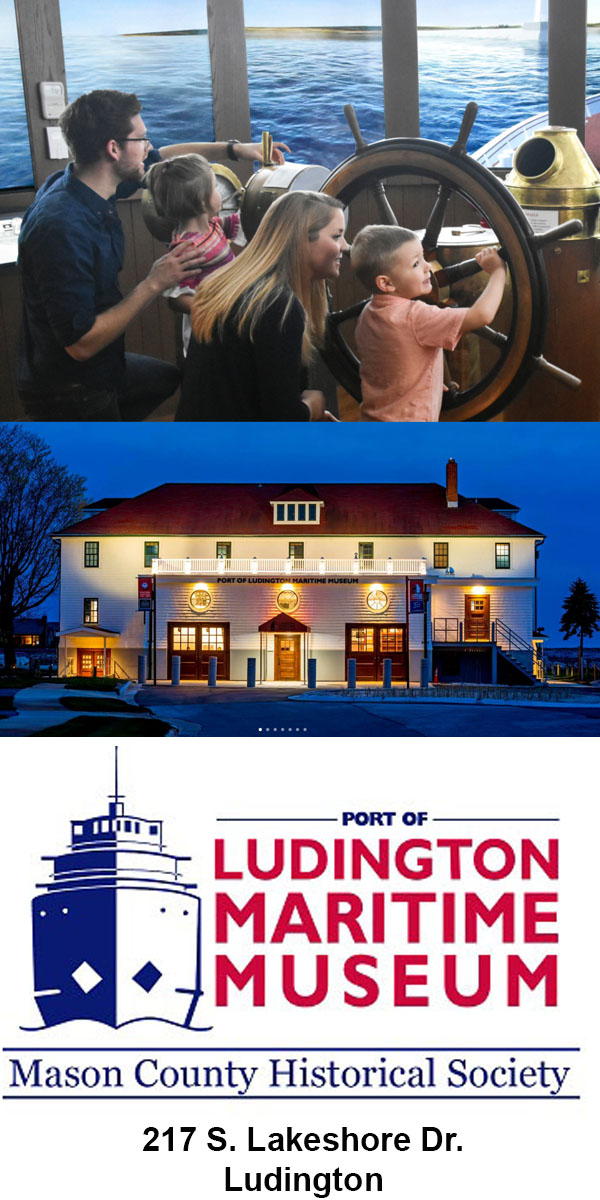
A view of the FM-2’s cockpit in the Flight Discovery Center.
Kalamazoo Air Zoo offers glimpse at aviation history, real-time restoration
MI Travelogue is a presentation of Preferred Credit Union, www.preferredcu.org, located locally at 266 N. Jebavy Dr., Ludington.
By Rob Alway, Editor-in-Chief
KALAMAZOO — The Kalamazoo Air Zoo Aerospace and Science Museum is located at the Kalamazoo International Airport. The museum has an impressive diverse collection of airplanes that span the entire 20th century.

An F-117 stealth bomber that was restored at the museum.
Possibly more impressive than the collection of aircraft is the fact that the museum has a team of volunteers who are some of the best aircraft restorers in the country. The zoo is one of the few aeronautic museums certified by the Department of Defense, NASA and the Smithsonian to perform restoration on federally-owned historical aircraft. Visitors are able to see the restoration work take place, seven days a week, in the museum’s Flight Discovery Center.
My two brothers, Tom and Rick, and I, brought my dad, Dick, to the museum recently. It was my first visit.
We were fortunate to get a behind-the-scenes tour of some of the current aircraft restorations. Anyone who knows me and anyone who knows the Alway family, knows that I come from a line of mechanically-inclined people. I, however, did not inherit that particular trait. But, Wayne, one of the volunteer restorers, recognized “the look” that my brothers and Dad had as they peered over the barricades watching the restoration efforts of circa 1940 Douglas SBD-1 Dauntless and a circa late 1930s, Grumman FM-2 Wildcat, both fighter planes. Both planes were used for carrier training on the Great Lakes during World War II and both crashed into the lake.
 The Dauntless’s pilot, Ensign Herbert Welton McMinn, of the U.S. Naval Reserve, died on Nov. 21, 1942 when his plane crashed into Lake Michigan while on a training flight near Chicago. It was one of 38 Dauntless planes that ended up on the bottom of Lake Michigan. During World War II, several freighter ships were converted to training aircraft carriers in the Great Lakes. McMinn was part of the Carrier Qualification Unit based at the Naval Reserve Aviation Base in Glenview, Ill.
The Dauntless’s pilot, Ensign Herbert Welton McMinn, of the U.S. Naval Reserve, died on Nov. 21, 1942 when his plane crashed into Lake Michigan while on a training flight near Chicago. It was one of 38 Dauntless planes that ended up on the bottom of Lake Michigan. During World War II, several freighter ships were converted to training aircraft carriers in the Great Lakes. McMinn was part of the Carrier Qualification Unit based at the Naval Reserve Aviation Base in Glenview, Ill.
The plane remained on the bottom of Lake Michigan until the early 1990s when it was salvaged and sent to the National Museum of Naval Aviation in Pensacola, Fla. for restoration. It was assigned to the battleship USS Alabama museum for a time but was later returned to Pensacola.
According to Wayne, any plane owned by the Navy remains property of the Navy regardless of its age or condition.
The Wildcat skidded from the deck of the USS Sable carrier on Dec. 18, 1944. In 2012 it was retrieved from the lake and was transferred to the Air Zoo’s Restoration Center in August 2013. It is on loan from the Naval Aviation Museum in Pensacola.
To learn more about the Air Zoo, click here.

This story is copyrighted © 2023, all rights reserved by Media Group 31, LLC, PO Box 21, Scottville, MI 49454. No portion of this story or images may be reproduced in any way, including print or broadcast, without expressed written consent.
As the services of Media Group 31, LLC are news services, the information posted within the sites are archivable for public record and historical posterity. For this reason it is the policy and practice of this company to not delete postings. It is the editor’s discretion to update or edit a story when/if new information becomes available. This may be done by editing the posted story or posting a new “follow-up” story. Media Group 31, LLC or any of its agents have the right to make any changes to this policy. Refer to Use Policy for more information.
Please consider helping to fund local news. Mason County Press and Oceana County Press are available for free thanks to the generous support of our advertisers and individuals. Three ways to help us: Venmo: @MasonCountyPress; Paypal: MasonCountyPress@gmail.com; Mail a check to PO BOX 21, Scottville, MI 49454.

















































.png)













 (1).gif)





